Dracaena | White and Jade Jewel Plant | Care Difficulty – Easy

 Add to favorites
Add to favorites
I am going to cover two plants in one today. Both are a white variegated Dracaena; one is called White Jewel and the other is a Jade Jewel. They require the same care–it’s just their coloring that differentiates them. In fact, I find it difficult to tell these two Dracaena plants apart. They both have strong white striping that contrasts beautifully with the broad-leafed, deep-green background. This species of the Dracaena family is a compact plant, which makes a stunning tabletop display.
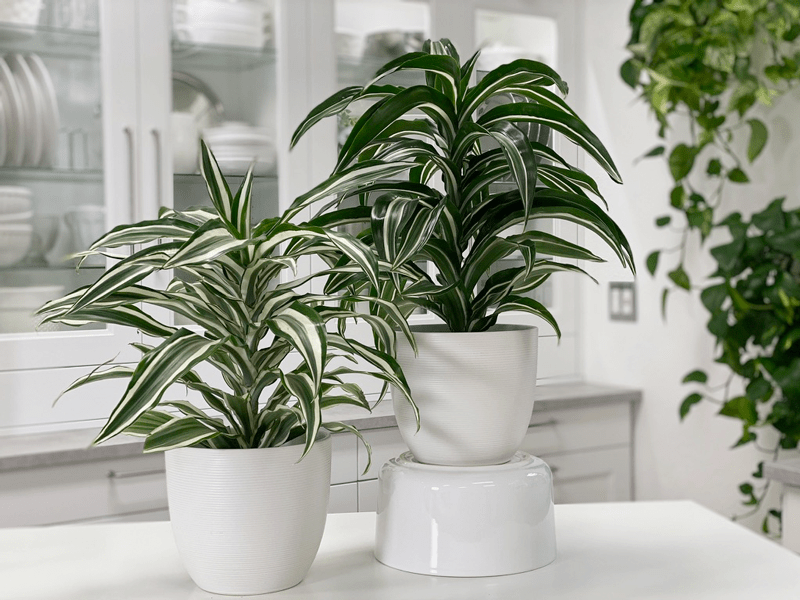
Water Requirements
These plants have a reputation for not needing a lot of water. True, but they need a thorough soaking when the soil dries out! It is best to use filtered water, rainwater, or distilled water since they don’t like salts or minerals. Dracaenas prefer dry soil. If the soil remains soggy, it will promote fungus and root rot.
Light Requirements
A mix of sunshine and shade is ideal for this dracaena, but it’s best to avoid direct sunlight. Although it grows quicker and better in bright light, you’ll also find it survives and thrives well enough in low light conditions.
Temperature Requirements
It prefers temperatures between 65 – 75 degrees (F). Under 55 degrees (F) will harm the plant, which may become noticeable if the leaves begin curling. Try to avoid placing the plant near cold drafts, which will also cause harm.
Fertilizer: Plant Food
I feed mine once a month during the growing season with a 1/4 diluted complete liquid fertilizer.
Plant Characteristics to Watch For
Diagnosing what is going wrong with your plant is going to take a little detective work, but even more patience! First of all, don’t panic and don’t throw out a plant prematurely. Take a few deep breaths and work down the list of possible issues. Below, I am going to share some typical symptoms that can arise. When I start to spot troubling signs on a plant, I take the plant into a room with good lighting, pull out my magnifiers, and begin by thoroughly inspecting the plant.
The leaves have brown tips
- If your Dracaena has brown leaf tips, it can be a sign of low humidity, or the soil has been dry for too long.
- Solution: Try boosting humidity with a room humidifier. But first, double-check and make sure that you have the plant on a proper watering schedule.
The leaves have black tips
- This can be a sign of overwatering.
- Solution: Double check the watering schedule and back off if the soil is really wet. Refer to watering requirements above and adjust accordingly.
Brown, dry spots on some of the leaves
- This problem is probably due to inconsistent watering. If the soil dries out too much, the tips of the leaves will present with brown tips and spots.
- Solution: Be consistent with your watering, but water only when needed. Check your plants about every 7 to 10 days and remember that our homes are often hot and dry in the winter, so plants may need to be watered more often.
The leaves have brown edges
- Brown edges on a leaf can be a sign of chlorine and/or fluoride in the tap water or a build-up of salts within the soil.
- Solution: Fill your watering can with tap water and allow it to sit uncovered for at least 24 hours so that the chlorine and fluoride can evaporate. Another option is to use rainwater or distilled water instead.
There are white deposits on the pot near the drain holes
- If you notice an accumulation of white deposits on the outside of the pot, this is a sign of excess salts.
- Solution: Use rainwater or distilled water to flush out excess salts.
Small brown spots trimmed in yellow
- If you notice this happening on your plant, it may have a leaf spot disease. The attacking fungus or bacteria leaves small brown spots trimmed in yellow, where it’s feeding on the leaves. These spots may vary in shape, color, and size.
- Solution: Immediately remove the affected leaves and isolate your Dracaena from your other plants for the time being. To treat leaf spot disease, try this homemade remedy of putting a tablespoon or two of baking soda and a teaspoon or two of mineral oil in a spray bottle of water. Shake the solution well and then spray all areas of the plant that are infected with brown spots.
The leaves are curling
- Curling leaves are a sign that the plant has been exposed to cold temperatures.
- Solution: Avoid putting the plant near cold drafts, windowsills, doorways, and air conditioners.

Additional Care
- Remove any dead, discolored, damaged, or diseased leaves and stems as they occur. Trim off brown leaf tips or spots with clean shears. Cut off only the damaged tips or spots, leaving a tiny margin of brown so as not to damage the remaining healthy foliage on the plant. If the entire leaf has turned brown, remove individual leaves at their base. Pull the leaf gently; it may come off on its own. If the leaf doesn’t separate with gentle pulling, snip through the stem with clean shears.
- Wipe leaves with a damp cloth to keep them free of pests and dust.
- Don’t use leaf shine on these plants.
- Use filtered water, as these plants are sensitive to salts and chemicals found in most tap water.
- If you want to reduce the size of the plant, simply cut off the top; over time, new foliage will grow back at the cut, producing a fuller look.
- If your plant isn’t thriving, try moving it to a spot with more light.
Common Bugs to Watch For
If you want to have healthy houseplants, you MUST inspect them regularly. Every time I water a plant, I give it a quick look-over. Bugs/insects feeding on your plants reduces the plant sap and redirects nutrients from leaves. Some chew on the leaves, leaving holes in the leaves. Also watch for wilting, yellowing, distorted, or speckled leaves. They can quickly get out of hand and spread to your other plants.
-
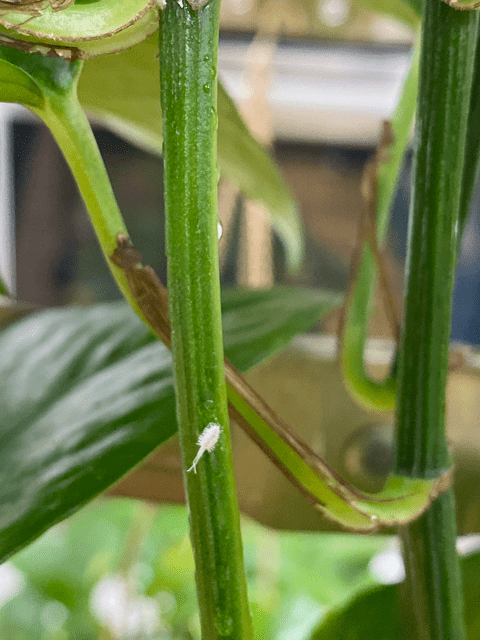
-
Mealybugs
-
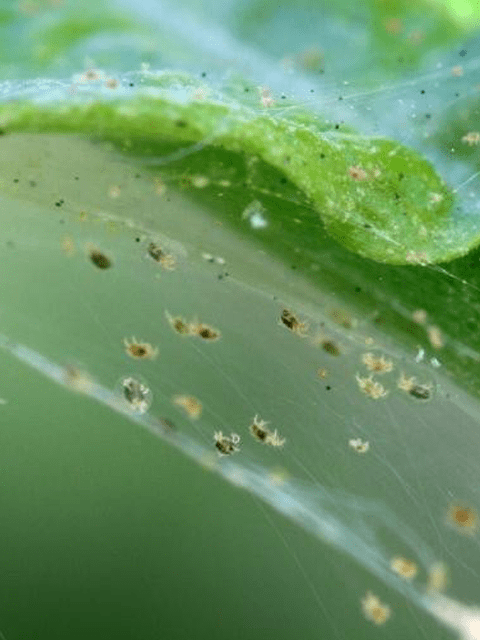
-
Spider mites
-
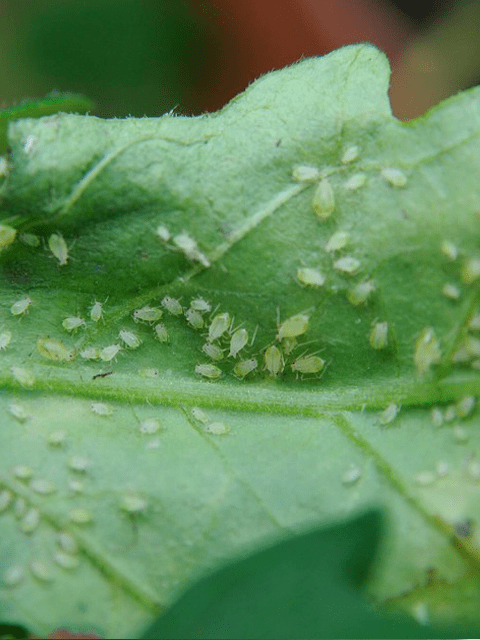
-
Aphids
-
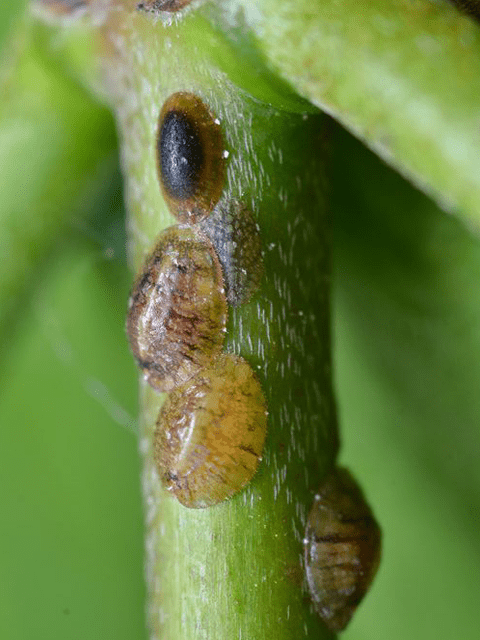
-
Scales
IF you see ONE bug, trust me, there are more. So, take action right away. Some are brave enough to show their “faces” by hanging out on stems in plan sight. Others tend to hide out in the darnedest of places.
- Mealybugs look like small balls of cotton. They can travel, slooooooowly, but they have a strong will and determination! Though they are slow-moving, if any plant is touching another, there is a chance the mealybug will hitch a ride on a new leaf and spread. They breed like rabbits of the insect world. Females can deposit around 600 eggs in loose cottony masses, often on the underside of leaves or along stems.
- Scales are dark-colored bumps that are primarily immobile insects that stick themselves to stems and leaves. They are rather inconspicuous and don’t look like a typical insect. They can range in color but are most often brownish in appearance. They’re called “scales” because of their scale-like appearance on a plant, due to waxy or armored coverings. They are often seen in clumps along a stem, sucking away at the plant’s juices with their spiky mouthpart.
- Aphids are more commonly seen if you place your plants outdoors. Aphids are indeed bugs. They are tiny insects that, along with black, also come in shades of yellow, green, brown, and pink. They are often found on the undersides of leaves.
- Spider mites are more common on houseplants. They are not insects – they are related to spiders. These appear to be tiny black or red moving dots. Spider mites are nearly invisible to the naked eye. You often need a magnifying lens to spot them, or you may just notice a reddish film across the bottom of the leaves, some webbing, or even some leaf damage, which usually results in reddish-brown spots on the leaf.
Toxicity
The sap is poisonous to animals. It is not considered toxic to people, but Dracaena is not fit for human consumption (stick to kale and spinach if you are craving greens). Keep it away from pets.
© AmieSue.com
Tags: Care Difficulty - Easy, Medium - Bright Light, Toxic to Pets and Humans


 Add to favorites
Add to favorites


Very Informative.
Thank you for this !!!
Very Informative!
Thank you for posting!!!
You are welcome :) I hope you found it helpful. amie sue
Hello, can you grow cuttings from this plant?
Good day Patricia,
This is one plant that I haven’t tried propagating. But I have read that you can lop off the top (crown) of the plant and place it in water so roots can grow. Then transfer to soil, much like a pothos propagation. I have even seen people pull off the leaves and place them in water, some producing roots. Though, I have never seen the final outcome of doing it that way so I am not sure what the success rate is on that method.
I am sorry that I don’t have the experience in doing this to share. blessings, amie sue
When is the growing season?
Good day Edith,
Growing season for most indoor houseplants is spring-fall. amie sue
Mine, is like having black on the tip of the leaves. I don’t know to prevent that. Thank you for your advice.
Hello Leo,
The leaves have black tips
This can be a sign of overwatering.
Solution: Double check the watering schedule and back off if the soil is really wet. Refer to watering requirements above and adjust accordingly.
I hope this helps :) amie sue
Recently purchased my Dracaena Jade Jewel plant 45cm 2+head after my other house plant of three yrs grew to a height of 7ft & eventually died through my ignorance of over watering or that was my conclusion. I want this new Dracaene Jade that looks stunning to have a long life & grow tall like the previous one. Can I ask if I’m better at keeping a watering log-diary to remind me of watering periods. Plus when to fertilise in growing season. Do you have example a calendar that gives same info of weekly watering checks for insects etc. I can see something like this would be very useful.
Good afternoon Peter,
I am sorry to hear about the loss of your large plant. That is always hard. I don’t have any watering charts. I used to be a scheduled waterer, but I found myself either over-watering or under-watering since each plant has its own needs and timing. Even the same species of plant, which has the same watering requirements, can differ from plant to plant based on its location in the house. Air vents, more light, less light, drafts from doors, the size of the plant, etc., all change up the watering needs of a plant.
I now water randomly as I see the need. It took a little time to adjust to this form of watering, but in the end, my plants are better off for it, and it’s less stressful for me. I do have one plant, Christmas Cactus, that is more finicky, and I use the calendar on my phone to notify me to water it every 4 days. It sends me a notification.
Best of luck with your new plant~ amie sue
The inside stem of my Dracaena dragon white jewel has gone brown. Not the leaves. Is it dead?
Hmmm, I am not really sure Nancy. I haven’t experienced that myself. If the plant is looking healthy (other than the stem) let it live and see what happens. One thing I would do is to remove it from the pot and may sure the roots are healthy. I am not sure of the brown stem is do to it rooting or just aging. I am sorry that I don’t have a clear answer on this one. Best of luck, amie sue
may I dew her leaves with watter
Yes you can Zorana. blessings, amie sue
Question. So which plant in the pix is the jade jewel, and which is the white jewel? What looks obvious may not be, I have tow that curls like you pix, and one has more white along the edge of the leaf, and the other has more white along the middle of the leaf. Thx in advance.
Hello Jack,
My understanding is that the one with the white more in the middle is the jade jewel and the one with the white more on the outer side of the leaf is the white jewel. Have a great day, amie sue